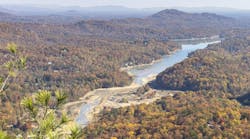
It seems quite a few people in California and other drought-affected areas are counting on a predicted wetter-than-normal winter to solve our problems. This article, titled “California’s New Hot Commodity: Stormwater,” describes how some farmers are hoping to flood their fields during the heavy winter rains they believe are coming, thus replenishing the aquifers from which they are already pumping water.
It seems quite a few people in California and other drought-affected areas are counting on a predicted wetter-than-normal winter to solve our problems. This article, titled “California’s New Hot Commodity: Stormwater,” describes how some farmers are hoping to flood their fields during the heavy winter rains they believe are coming, thus replenishing the aquifers from which they are already pumping water. [text_ad] The predicted El Niño conditions, which are making many city officials nervous as they anticipate urban flooding and mudslides, could in fact be a boon to farmers. (El Niño, Spanish for “the child” or “the little boy,” is caused by warmer-than-usual waters in the Pacific Ocean, leading to rainier conditions over parts of North America. La Niña [“the little girl”] is caused by lower-than-average temperatures in the Pacific, resulting in drier conditions. This NOAA site has more detailed explanations of the phenomena.) One farmer interviewed in the article says that during the 1980s, he saw vineyards survive for long periods even though the plants were submerged in water, and he’s been diverting stormwater to do the same with his own fields. In 2011, 300 acres of his vines were subjected to foot-deep water for about five months. The plants, he says, were fine, and he estimates he captured 3,000 acre-feet of water. He’s now working to get other farmers to do the same, which will replace some of the groundwater they’ve been pumping so heavily during the dry months. He thinks that collectively they could capture millions of acre-feet of water this winter. There are some caveats; certain types of trees such as almonds might blow over in a storm if the ground beneath them is heavily saturated. And the land being flooded must have the right type of soil—somewhat sandy and porous—to achieve good infiltration. But Daniel Mountjoy, the director of resource stewardship at the nonprofit environmental group Sustainable Conservation, says that with the right conditions farmers could capture from 3 to 10 feet of water per acre over the rainy season. The encouraging thing about this practice is that it’s causing farmers and officials to look at stormwater as a resource rather than as a nuisance to be gotten rid of. But questions remain about water rights. Do the farmers have the right to divert and capture stormwater? Many say yes, and they think they might actually receive some sort of compensation from the communities downstream that will be protected from flooding because of their actions. What do you see as the potential benefit of this practice—and should cities be doing more to capture stormwater as well? StormCon Call for Papers: One Week Left StormCon, the only North American event dedicated exclusively to stormwater and surface-water professionals, is seeking abstracts for presentation at StormCon 2016. The deadline for submitting abstracts is Wednesday, December 9. The conference will be held in Indianapolis, IN, August 22–25, 2016. We are looking for abstracts in the following conference tracks:- BMP Case Studies
- Green Infrastructure
- Stormwater Program Management
- Advanced Research Topics
- Water-Quality Monitoring
- Industrial Stormwater Management
- Stormwater Management for Solid Waste Facilities
The predicted El Niño conditions, which are making many city officials nervous as they anticipate urban flooding and mudslides, could in fact be a boon to farmers. (El Niño, Spanish for “the child” or “the little boy,” is caused by warmer-than-usual waters in the Pacific Ocean, leading to rainier conditions over parts of North America. La Niña [“the little girl”] is caused by lower-than-average temperatures in the Pacific, resulting in drier conditions. This NOAA site has more detailed explanations of the phenomena.)
One farmer interviewed in the article says that during the 1980s, he saw vineyards survive for long periods even though the plants were submerged in water, and he’s been diverting stormwater to do the same with his own fields. In 2011, 300 acres of his vines were subjected to foot-deep water for about five months. The plants, he says, were fine, and he estimates he captured 3,000 acre-feet of water. He’s now working to get other farmers to do the same, which will replace some of the groundwater they’ve been pumping so heavily during the dry months. He thinks that collectively they could capture millions of acre-feet of water this winter.
There are some caveats; certain types of trees such as almonds might blow over in a storm if the ground beneath them is heavily saturated. And the land being flooded must have the right type of soil—somewhat sandy and porous—to achieve good infiltration. But Daniel Mountjoy, the director of resource stewardship at the nonprofit environmental group Sustainable Conservation, says that with the right conditions farmers could capture from 3 to 10 feet of water per acre over the rainy season.
The encouraging thing about this practice is that it’s causing farmers and officials to look at stormwater as a resource rather than as a nuisance to be gotten rid of. But questions remain about water rights. Do the farmers have the right to divert and capture stormwater? Many say yes, and they think they might actually receive some sort of compensation from the communities downstream that will be protected from flooding because of their actions.
What do you see as the potential benefit of this practice—and should cities be doing more to capture stormwater as well?
StormCon Call for Papers: One Week Left
StormCon, the only North American event dedicated exclusively to stormwater and surface-water professionals, is seeking abstracts for presentation at StormCon 2016. The deadline for submitting abstracts is Wednesday, December 9.
The conference will be held in Indianapolis, IN, August 22–25, 2016. We are looking for abstracts in the following conference tracks:
- BMP Case Studies
- Green Infrastructure
- Stormwater Program Management
- Advanced Research Topics
- Water-Quality Monitoring
- Industrial Stormwater Management
- Stormwater Management for Solid Waste Facilities
About the Author
Janice Kaspersen
Janice Kaspersen is the former editor of Erosion Control and Stormwater magazines.


